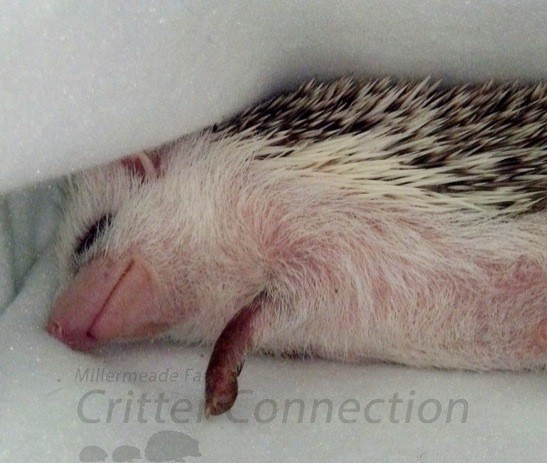Last Updated on August 25, 2022.
In the Wild
- European hedgehog species hibernate in the wild when the temperature becomes too cold. They spend the warmer months building fat reserves to sustain them through their periods of inactivity.
- In the wild, African hedgehog species may go into a dormant period of inactivity called estivation (also spelled aestivation; see below for a definition) when the weather is too hot and dry in the summer.
- Hedgehogs are very vulnerable when they wake up from hibernation or estivation.
- In such a weak state, hedgehogs are easy targets for predators. Some hedgehogs are unable to recover from hibernation or estivation and die from related illnesses.
In Captivity
- Hedgehogs in captivity can also enter periods of partial hibernation.
- Indoor room temperatures that are too cool can induce a false hibernation attempt.
- Some hedgehogs attempt hibernation in response to barometric pressure changes or external temperature changes even though the indoor temperature is acceptable.
- Captive, bred hedgehogs generally have lost the ability to recover from hibernation. As a result, hibernation attempts by pet hedgehogs are very dangerous and can result in death if the animal is not given immediate attention.
- Estivation attempts are rare for pet hedgehogs, but are equally dangerous.
- Hedgehogs living in captivity should be kept in a controlled environment to help prevent hibernation and estivation.
Signs and Symptoms
- When the hedgehog begins to hibernate, it will be cold to touch.
- A hibernating hedgehog may appear to be in a deep sleep called torpor.
- Hedgehogs may become lethargic to the point that they may not be able to ball up or uncurl at all.
- The hedgehog will be unsteady or shaky on its feet as if drunk when it is able to uncurl. Don’t confuse this with Wobbly Hedgehog Syndrome. Hibernation wobbliness occurs suddenly and is often completely treatable.
- A decrease in appetite or complete cessation of eating are other symptoms.
Cause
- A decrease in ambient room temperature or a draft can cause your hedgehog to become too cool and start to hibernate. Temperatures as high as 68˚F can induce hibernation.
- The shortening of daylight hours in the fall may also cause your hedgehog to attempt hibernation.
- Barometric pressure changes or sudden drops in outdoor temperatures can also cause your hedgehog to start hibernation.
- Once a hedgehog hibernates, it is more prone to future hibernation attempts.
Immediate Treatment
- Regardless of the cause of hibernation, it is very important to warm your hedgehog immediately, but very slowly.
- You can place your hedgehog under your shirt next to your body. This is probably the prickliest, but the safest and quickest method. You will know your hedgehog is warmed up and ready to go when it starts moving around and you can’t keep it in one place.
- You can also warm your hedgehog on a heating pad or by wrapping it in a towel warmed in the dryer.
- NEVER LEAVE A HEDGEHOG UNATTENDED WITH A HEATING PAD. Serious burns or death may result.
Veterinary Treatment
- Once your hedgehog begins to warm up, take it to a vet to determine if its symptoms were truly due to hibernation and not some other life-threatening illness.
- Delay in care for any illness can result in death.
- Line up good vets in advance, preferably ones with exotic pet experience, so that when you need veterinary assistance you will be able to quickly get your hedgehog the care it needs.
- Be aware that not all veterinarians treat hedgehogs, and those who do may not take emergency cases.
Long-Term Treatment
- When you return from the vet, you will need to take extra precautions to ensure that your hedgehog does not attempt to hibernate again.
- If possible, increase the room temperature and monitor for fluctuations during the day and night.
- Check for drafts in the room by lighting a candle and watching for flicker in the flame. Drafts may be an issue during periods of high winds if the cage is near a leaky window. Drafts can also emanate from heating and cooling vents.
- You can add heat to the cage by using a SnuggleSafe Disc (a microwaveable puppy warmer good for 12 hours), a reptile heating pad that adheres to the bottom of the cage, or a black or red heat bulb over the cage.
- Avoid human-grade heating pads that turn off after a certain length of time and reptile heat rocks, which can get too hot.
- The best way to monitor the daily high and low temperatures in your hedgehog’s cage is with a digital high/low thermometer that you can purchase at stores such as Radio Shack.
- A natural light cycle is important for preventing repeat hibernations. Maintain regular day and night light cycles. Use additional light during daylight hours only if there is not enough natural sunshine in the room. Covering a cage for warmth decreases the amount of light in the cage.
- Choose warm, fluffy bedding that will help conserve body heat. Layers of fleece or Vellux will provide a cozy place to snuggle.
The following definition was taken from Wikipedia.
Aestivation (from Latin aestas, summer, but also spelled “estivation” in the USA) is a state of animal dormancy, characterized by inactivity and a lowered metabolic rate that is entered in response to high temperatures and arid conditions. It takes place during times of heat and dryness, the hot dry season, which is often, but not necessarily the summer months.
Invertebrate and vertebrate animals are known to enter this state to avoid damage from high temperatures and the risk of desiccation. Both terrestrial and aquatic animals undergo aestivation.
Aestivation. (2012). Retrieved February 6, 2012, from http://en.wikipedia.org/wiki/Aestivation
Contributors: Gail Smith, Melissa Ramos






